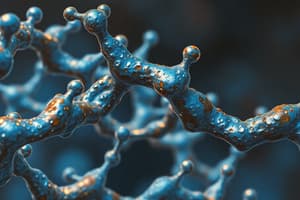Podcast
Questions and Answers
What is the primary role of enzymes in chemical reactions?
What is the primary role of enzymes in chemical reactions?
- To increase the rate of chemical reactions (correct)
- To change the reactants into different substances
- To alter the products of the reaction
- To permanently modify reactants
Which type of enzyme structure is formed when an apoenzyme combines with its cofactor?
Which type of enzyme structure is formed when an apoenzyme combines with its cofactor?
- Metalloenzyme
- Substrate complex
- Holoenzyme (correct)
- Cofactor component
What is denaturation of an enzyme?
What is denaturation of an enzyme?
- The breakdown of the enzyme into amino acids
- The irreversible formation of new enzymes
- The change of an enzyme's substrate
- The alteration of enzyme's structure affecting its activity (correct)
Which amino acid type is characterized as hydrophilic?
Which amino acid type is characterized as hydrophilic?
What does the integrity of an enzyme's protein structure influence?
What does the integrity of an enzyme's protein structure influence?
What are cofactors in relation to enzymes?
What are cofactors in relation to enzymes?
Which of the following factors does NOT affect the rate of enzymatic reactions?
Which of the following factors does NOT affect the rate of enzymatic reactions?
What is the correct definition of an apoenzyme?
What is the correct definition of an apoenzyme?
What is the primary entity transferred by Coenzyme A during reactions?
What is the primary entity transferred by Coenzyme A during reactions?
Which coenzyme functions as a co-substrate in transamination reactions?
Which coenzyme functions as a co-substrate in transamination reactions?
What is the irreversible effect of dissociating biotin from its enzyme?
What is the irreversible effect of dissociating biotin from its enzyme?
Which of the following is NOT a correct pairing of a coenzyme and the entity it transfers?
Which of the following is NOT a correct pairing of a coenzyme and the entity it transfers?
In the conversion involving succinate and FAD, what is the final product formed?
In the conversion involving succinate and FAD, what is the final product formed?
What describes the role of a prosthetic group in enzymatic reactions?
What describes the role of a prosthetic group in enzymatic reactions?
Which coenzyme is primarily involved in the transfer of hydrogen atoms?
Which coenzyme is primarily involved in the transfer of hydrogen atoms?
Which of the following reactions demonstrates the use of NAD+ as a coenzyme?
Which of the following reactions demonstrates the use of NAD+ as a coenzyme?
What is the primary reaction catalyzed by pyruvate carboxylase?
What is the primary reaction catalyzed by pyruvate carboxylase?
Which type of specificity allows an enzyme to act on a variety of substrates that share a functional group?
Which type of specificity allows an enzyme to act on a variety of substrates that share a functional group?
Why are microbes preferred over plant and animal sources for enzyme production?
Why are microbes preferred over plant and animal sources for enzyme production?
Which of the following statements about the specificity of enzymes is correct?
Which of the following statements about the specificity of enzymes is correct?
Which of the following is a potential disadvantage of using plant and animal enzymes compared to microbial enzymes?
Which of the following is a potential disadvantage of using plant and animal enzymes compared to microbial enzymes?
What is the primary function of an allosteric enzyme?
What is the primary function of an allosteric enzyme?
What are immobilized enzymes best known for?
What are immobilized enzymes best known for?
Which enzyme is paired correctly with its required metal cofactor?
Which enzyme is paired correctly with its required metal cofactor?
Which statement about metalloenzymes is true?
Which statement about metalloenzymes is true?
What role do coenzymes typically play in enzymatic reactions?
What role do coenzymes typically play in enzymatic reactions?
Isoenzymes are characterized by which of the following?
Isoenzymes are characterized by which of the following?
Which of the following statements regarding metal cofactors is incorrect?
Which of the following statements regarding metal cofactors is incorrect?
What is the significance of effector molecules for allosteric enzymes?
What is the significance of effector molecules for allosteric enzymes?
Flashcards
What are enzymes?
What are enzymes?
Enzymes are special proteins that act as catalysts, speeding up chemical reactions without being consumed in the process.
What are substrates and products?
What are substrates and products?
The molecules that enzymes work on are called substrates. Enzymes bind to substrates, convert them into products, and then release the products.
What is enzyme specificity?
What is enzyme specificity?
Enzymes are very specific, meaning each enzyme typically works on only one or a few specific types of substrates. This is due to the unique shape of the enzyme's active site.
What is denaturation?
What is denaturation?
Signup and view all the flashcards
What is a cofactor?
What is a cofactor?
Signup and view all the flashcards
What is an apoenzyme?
What is an apoenzyme?
Signup and view all the flashcards
What is a holoenzyme?
What is a holoenzyme?
Signup and view all the flashcards
What is the active site of an enzyme?
What is the active site of an enzyme?
Signup and view all the flashcards
Allosteric enzyme
Allosteric enzyme
Signup and view all the flashcards
Immobilized Enzymes
Immobilized Enzymes
Signup and view all the flashcards
Isoenzyme
Isoenzyme
Signup and view all the flashcards
Metalloenzymes
Metalloenzymes
Signup and view all the flashcards
Coenzyme
Coenzyme
Signup and view all the flashcards
Metal cofactors
Metal cofactors
Signup and view all the flashcards
Flavin adenine dinucleotide (FAD)
Flavin adenine dinucleotide (FAD)
Signup and view all the flashcards
Flavin mononucleotide (FMN)
Flavin mononucleotide (FMN)
Signup and view all the flashcards
Coenzyme (general function)
Coenzyme (general function)
Signup and view all the flashcards
What is a co-substrate?
What is a co-substrate?
Signup and view all the flashcards
What is a prosthetic group?
What is a prosthetic group?
Signup and view all the flashcards
What is the role of biotin, a prosthetic group, in carboxylase enzymes?
What is the role of biotin, a prosthetic group, in carboxylase enzymes?
Signup and view all the flashcards
What is the role of pyridoxal phosphate, a co-substrate, in transamination reactions?
What is the role of pyridoxal phosphate, a co-substrate, in transamination reactions?
Signup and view all the flashcards
What is the role of NAD+ in biochemical reactions?
What is the role of NAD+ in biochemical reactions?
Signup and view all the flashcards
What is the role of FAD in biochemical reactions?
What is the role of FAD in biochemical reactions?
Signup and view all the flashcards
How does NAD+ participate in the conversion of glyceraldehyde 3-phosphate to 1,3-bisphosphoglycerate?
How does NAD+ participate in the conversion of glyceraldehyde 3-phosphate to 1,3-bisphosphoglycerate?
Signup and view all the flashcards
How does FAD participate in the conversion of succinate to fumarate?
How does FAD participate in the conversion of succinate to fumarate?
Signup and view all the flashcards
Pyruvate Carboxylase Reaction
Pyruvate Carboxylase Reaction
Signup and view all the flashcards
Absolute Specificity
Absolute Specificity
Signup and view all the flashcards
Group Specificity
Group Specificity
Signup and view all the flashcards
Linkage Specificity
Linkage Specificity
Signup and view all the flashcards
Stereochemical Specificity
Stereochemical Specificity
Signup and view all the flashcards
Study Notes
Enzymology
- Enzymology is the study of enzymes
- Enzymes are proteins that act as catalysts, increasing the rate of chemical reactions.
- Enzymes catalyze the binding of reactants (substrates), converting them to products, and releasing the products.
- Enzymes return to their original form after the reaction.
- Enzyme function depends on their protein structure integrity.
- Factors that disrupt the native conformation of the enzyme's polypeptide chains can lead to loss of catalytic activity.
Enzyme Structure
- Enzymes are composed mainly of 20 naturally occurring amino acids.
- Each amino acid conforms to the general formula: H₃N⁺-CH(R)-COO⁻ at a neutral pH.
- Structural analysis of enzymes is done through methods of protein chemistry, molecular biology, and molecular biophysics.
- There are specific classifications of amino acid chains based on their properties - Aliphatic, Hydrophilic, Sulfur-Containing, Aromatic, and Other. (figures showing structures are available in the provided images).
Enzyme Denaturation
- Denaturation is the partial or total alteration of an enzyme's structure, without changing its covalent structure.
- Denaturation can be caused by physical procedures (heating, agitation) or chemical agents.
- Denaturation can be reversible or irreversible.
Structural Function Relationship
- The catalytic activity of an enzyme relies on the integrity of its protein structure.
- Factors disrupting the native conformation of the enzyme polypeptide chains lead to loss of catalytic activity.
Terminologies Related to Enzymes
- Cofactor: A non-protein chemical component required for enzyme activity (e.g., metal ions, organic molecules called coenzymes).
- Apoenzyme: The protein portion of an enzyme, without its cofactor.
- Holoenzyme: The complete, active enzyme composed of apoenzyme + cofactor.
- Examples of metal ions as cofactors for specific enzymes (metalloenzymes): Ca²⁺ (Lipase), Cu²⁺/Cu⁺ (Cytochrome oxidase, tyrosinase, etc.), Fe²⁺/Fe³⁺ (Cytochrome oxidase, etc.), K⁺ (Pyruvate kinase), Mg²⁺ (Hexokinase, etc.), Mn²⁺ (Arginase, etc.), Ni²⁺ (Urease), Zn²⁺ (Carbonic anhydrase, etc.)
Coenzymes
- Many coenzymes are derived from dietary water-soluble vitamins.
- Coenzymes are involved in various biochemical reactions as either co-substrates or prosthetic groups.
- Coenzymes function as donors or acceptors of chemical groups during biochemical reactions.
- Examples include coenzyme A, Flavin adenine dinucleotide (FAD), and Nicotinamide adenine dinucleotide (NAD⁺). (structural formulas are included in the images)
- Reactions involving NAD⁺ and FAD are presented in the provided images. These show how they are used in specific biochemical reactions.
Co-substrates
- Transient associates with the enzyme's active site.
- Chemically modified during a reaction.
- Released after the reaction is complete and free to participate in other reactions.
- An example is pyridoxal phosphate in a transamination reaction. This acts as a temporary carrier for amino groups.
Prosthetic Groups
- Permanently bound to the enzyme's active site (either covalently or non-covalently).
- Dissociation causes irreversible loss of catalytic activity.
- An example is biotin, which is part of carboxylase enzymes.
- Biotin is essential for the formation of oxaloacetate from pyruvate. (reaction shown in the provided images)
Enzyme Specificity
- Enzymes display varying degrees of specificity for their substrates.
- There are four types of specificity:
- Absolute specificity: catalyze only one reaction.
- Group specificity: catalyze reactions involving a specific functional group.
- Linkage specificity: catalyze reactions involving a certain chemical bond.
- Stereochemical specificity: act on a particular steric or optical isomer.
Sources of Enzymes
- Enzymes occur in all living organisms.
- Microbes are often preferred sources due to their relatively low cost of production, rapid growth in inexpensive media, and stability of the enzymes produced.
- Plant and animal tissues may contain inhibitors or harmful compounds.
Studying That Suits You
Use AI to generate personalized quizzes and flashcards to suit your learning preferences.




